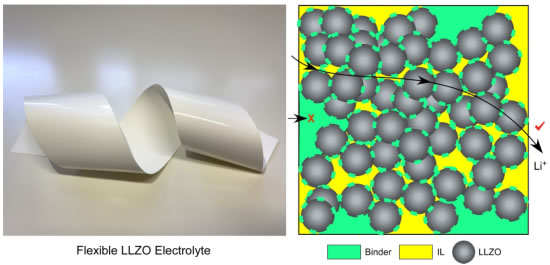Japan's synthesis of ceramic flexible sheet electrolytes at room temperature can accelerate lithium metal batteries
According to foreign media reports, Tokyo, Japan ’s capital university (changed to Tokyo Metropolitan University in April), has developed a new method for creating ceramic flexible electrolyte sheets for lithium metal batteries. The researchers mixed garnet-type ceramics, polymer binders and an ionic liquid to create a solid-like sheet electrolyte. Since the researchers are synthesizing at room temperature, the energy consumption of this new method is greatly reduced compared to the existing processes performed at high temperatures (> 1000 ° C). In addition, the electrolyte can work in a wide temperature range, is a very promising electrolyte, can be used in batteries of electric vehicles and other equipment. Fossil fuels meet most of the world's energy needs, including electricity. However, fossil fuels are being depleted, and burning fossil fuels will cause other pollutants such as carbon dioxide and toxic nitrogen oxides to be directly discharged into the atmosphere. The world needs to transition to cleaner renewable energy, but renewable energy from wind and solar energy is often intermittent, because the wind does not blow all the time, and there is no sun at night. Therefore, it is necessary to develop advanced energy storage systems to more efficiently use this intermittent renewable energy. Since the commercialization of lithium-ion batteries by Sony in 1991, such batteries have had a profound impact on modern society, providing power for a variety of portable electronic products and household appliances such as cordless vacuum cleaners. However, electric vehicles still require the most advanced lithium-ion technology, and battery capacity and safety need to be greatly improved. Therefore, many scientists began to study lithium metal batteries. Because in theory, the capacity of lithium metal anodes is higher than that of existing commercial graphite anodes. However, there are still technical obstacles to lithium metal anodes. For example, in a liquid battery, lithium dendrites may grow, resulting in a short circuit of the battery, and even fire and explosion. However, solid inorganic electrolytes are significantly safer. The garnet-type (structural shape) ceramic Li7La3Zr2O12, or LLZO, is widely regarded as a promising solid electrolyte material due to its high ionic conductivity and compatibility with lithium metal. However, the production of high-density LLZO electrolyte requires a sintering temperature of up to 1200 ° C, which is a waste of energy and time, making it difficult to mass-produce LLZO electrolyte. In addition, LLZO electrolyte is very brittle, and its physical contact performance with electrode materials is poor, which usually results in high contact interface resistance, which greatly limits its application in all-solid lithium metal batteries. Therefore, a research team at Tokyo Metropolitan University, under the leadership of Professor Kiyoshi Kanamura, began to develop a flexible composite LLZO sheet electrolyte that can be produced at room temperature. The researchers poured LLZO ceramic mud on a thin polymer substrate, just like butter on toast. Then, it is placed in a vacuum oven for drying. Afterwards, the 75-micron-thick sheet electrolyte is immersed in an ionic liquid (IL) to increase its ionic conductivity. Ionic liquids are liquid salts at room temperature. As we all know, their conductivity is high, and they are almost non-flammable and non-volatile. Inside the sheet electrolyte, the ionic liquid successfully filled the tiny gaps in the structure, bridged the LLZO particles, and formed an effective channel for lithium ions; in addition, it also effectively reduced the resistance of the cathode contact interface. In further research, the researchers found that the lithium ions in the structure diffused in both the ionic liquid and the LLZO particles, so both the ionic liquid and the LLZO particles played a prominent role. The synthesis method is very simple, suitable for industrial production, and the whole process is carried out at room temperature without high temperature sintering. Although there are still some challenges, the research team said that the mechanical robustness and operability of the flexible composite sheet electrolyte makes it able to work in a wider temperature range, making it ideal for lithium metal batteries. Electrolyte. The new synthesis method is very simple, which also means that this high-capacity lithium metal battery may be seen on the market sooner than expected. (Yu Qiuyun) Wireless Remote Control Grow Light 100W Wireless Remote Control Grow Light 100W,LED Plant Lighting,Square Grow LED Light,Square Plant Light Yichang Green Eco-agriculture Co., Ltd. , https://www.plantgrowlamp.com
(Source: Tokyo Metropolitan University)